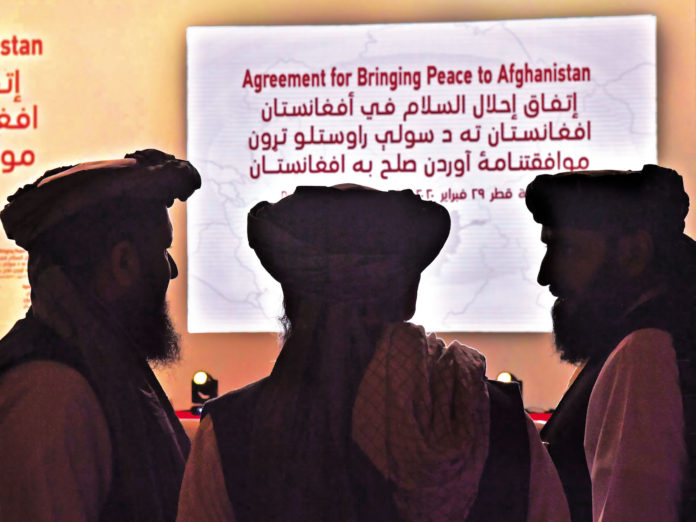The United States signed a deal with the Taliban, on 29 February, that sets the stage to end America’s longest war – the nearly two-decade-old conflict in Afghanistan that began after the September 11 attacks, killed tens of thousands of people, vexed three White House administrations and left mistrust and uncertainty on all sides.
The chief American envoy, Zalmay Khalilzad, signed on behalf of the United States. Mullah Abdul Ghani Baradar, a current Taliban deputy and a figure from the original Taliban government, signed for the Taliban.
The agreement lays out a timetable for the final withdrawal of American troops from Afghanistan, the impoverished Central Asian country once unfamiliar to many Americans that now symbolises endless conflict, foreign entanglements and a potential stage for terrorist plots. The Trump administration framed the deal as the long-awaited promise made to war-weary Americans, for whom the Afghan war has defined a generation of loss and trauma but has yielded no victory.
The agreement also hinges on more difficult negotiations to come between the Taliban and the Afghan government over the country’s future. Officials hope those talks will produce a power-sharing arrangement and lasting ceasefire, but both ideas have been anathema to the Taliban in the past.
“Since the deal is being signed today, and our people are happy and celebrating it, we have halted all our military operations across the country,” Taliban spokesman Zabihullah Mujahid said.
Joint Statement
According to the joint statement, the US will complete its troop withdrawal from Afghanistan within 14 months with the initial drawdown of forces from a total of 13,000 to 8,600 happening in the next four months. In the first 135 days, the US will reduce the number of US forces in Afghanistan to 8,600 and proportionally bring reduction in the number of its allies and coalition forces.


The withdrawal of US troops is dependent on the Taliban’s fulfilment of major commitments that have been obstacles for years, including its severance of ties with international terrorist groups such as al-Qaida.
The joint declaration asserted the US’ commitment to continue funding and supporting the Afghan military. Defense Secretary Mark Esper emphasized that if the Taliban did not honor their pledges, “the US would not hesitate to nullify the agreement.”
“If the Taliban and the government of Afghanistan live up to these commitments, we will have a powerful path forward to end the war in Afghanistan and bring our troops home,” President Donald Trump said, on 28 February, before the signing of the deal. “These commitments represent an important step to a lasting peace in a new Afghanistan, free from al-Qaida, ISIS, and any other terrorist group that would seek to bring us harm.”
Any insurgent pledge to guarantee Afghanistan is never again used by jihadist movements such as Al-Qaeda and the Islamic State group to plot attacks abroad will be key to the deal’s viability. The Taliban’s sheltering of Al-Qaeda was the main reason for the US invasion following the 9/11 attacks.
Afghan Government – Taliban Talks
The intra-Afghan peace talks, involving representatives from the Afghan government, the Taliban and various other groups, will be held in Norway’s capital Oslo by March 10. The United States will be present, but this will be an intra-Afghan negotiation. The United Nations would also be playing a role.
Throughout this period, the reduction in violence remains in place, so it will give the US a good opportunity to test the durability of the reduction in violence and also perhaps set a better stage for it to move towards a permanent ceasefire once all the parties are at the table.
As part of the agreement, the US has established a communications channel, which is currently based in Doha, where it will continue its role of mediating between the Taliban and the Afghan government.
They need to identify the many difficult types of issues. For example, security forces, how do they begin consolidation; reconciliation, how do they do that; sort of what their governance structure should be.
Afghan Government Excluded
The position of the Afghan government, which has been excluded from direct US-Taliban talks, remains unclear and the country is gripped by a fresh political crisis amid contested election results.
From the start of the talks, late in 2018, Afghan officials were troubled that the Taliban had blocked them from participating. They worried that Trump would abruptly withdraw troops from Afghanistan without securing any of the conditions they saw as crucial, including a reduction in violence and a Taliban promise to negotiate in good faith with the government.
Costs of War
The US has been fighting a war in Afghanistan for more than 18 years. It has become, by far, its longest war, leading to a loss of about 2,400 American lives. Both President George W Bush, who began the war in 2011, and his successor Barack Obama wanted to bring it to a close, but failed. During his election campaign President Donald Trump, who succeeded Obama in January 2017, made a commitment to end it and bring the ‘boys’ home.
The war cost $2 trillion and took the lives of more than 3,500 American and coalition troops and tens of thousands of Afghans since the US invasion in the aftermath of the 9/11 attacks, which were plotted by al-Qaida leaders under the protection of the Taliban.
At the height of the war, more than 100,000 U.S. troops occupied Afghanistan, as did tens of thousands from about 40 nations in the U.S.-led NATO coalition. The war has gone on so long – the first allied warplane and cruise missiles struck on 7 October 2001, and American boots hit the ground in numbers on 19 October- that many young Afghan soldiers and their coalition partners have no memory of its onset.
In the more than 18-year-long Afghan war 100,000 Afghan civilians have been killed or injured, according to the United Nations. Afghanistan remains one of the poorest countries in the world.
Some 2.5 million Afghans are registered as refugees abroad and another two million are displaced within their country.
The war has cost the US taxpayer more than $1 trillion in military and rebuilding costs since the US-led invasion of 2001.
The USA in 2018 alone incurred approximately $45 billion – “$5 billion for Afghan forces and $13 billion for US forces inside Afghanistan. Much of the rest is for logistical support. Some $780 million goes toward economic aid”.
Major defence contractors like Lockheed Martin, which alone bagged defence-related contracts of over $36 billion in fiscal 2015 (the most recent statistics available about it ). The top 100 defence contractors received $175 billion from the Pentagon in the fiscal year 2015, nearly one-third of the Department of Defense’s entire budget.
Comments
The future is fraught with uncertainties. The government in Kabul had primarily been a bystander in the talks. The Taliban, who control most of the country outside the capital, have been dismissive of the government’s legitimacy. The coming days will test the alliances between various factions, something that has an inordinately large role in Afghan social and political life.
For millions of war-scarred Afghans, the US-Taliban deal represents some hope for an end to years of bloodshed. But there were others who said they feared what comes next. Kabul shopkeeper Husain Ahmad said that while Afghans were “hungry for peace”, the agreement represented a victory for the insurgents whose stint in power from 1996 to 2001 saw the imposition of strict sharia law and confined women to their homes.
There is no doubt that the first objective of the US war was to eliminate the Al-Qaeda from Afghanistan. Afghan territory was used to plan and instigate attacks on US interests, including 9/11.
The US succeeded in pushing out the Al-Qaeda and the Taliban out of Afghanistan fairly quickly. The leaders of these groups, along with a large number of their followers, went into Pakistan. The US had to find and eliminate Laden through its own resources in May 2011.
A complete withdrawal of US forces raises the possibility that Afghanistan will become another safe haven for terrorist organisations under a Taliban government.
The war in Afghanistan in some ways echoes the American experience in Vietnam. In both, a superpower bet heavily on brute strength and the lives of its young, then walked away with seemingly little to show.
American efforts to instil a democratic system in the country, and to improve opportunities for women and minorities, are at risk if the Taliban, which banned girls from schools and women from public life, become dominant again. Corruption is still rampant, the country’s institutions are feeble, and the economy is heavily dependent on American and other international aid. The signing of the agreement in Doha, which followed more than a year of stop-and-start negotiations and conspicuously excluded the American-backed Afghanistan government, is not a final peace deal and could still unravel. But it is seen as a step toward negotiating a more sweeping agreement that some hope could eventually end the insurgency of the Taliban, the militant movement that once governed Afghanistan under a severe Islamic code.











